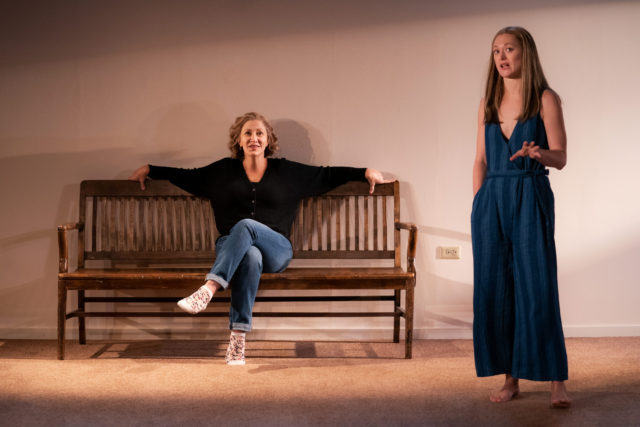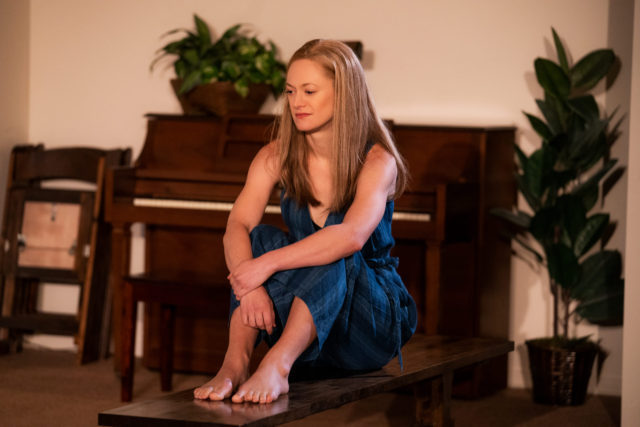
Edie Falco, Marin Ireland, and Blair Brown are extraordinary as three generations of one family in Morning Sun (photo © Matthew Murphy 2021)
MORNING SUN
Manhattan Theatre Club
MTC at New York City Center – Stage I
131 West 55th St. between Sixth & Seventh Aves.
Tuesday – Sunday through December 19, $99-$109
212-581-1212
www.manhattantheatreclub.com
Tony winner Simon Stephens’s Morning Sun opened tonight at New York City Center’s Stage I, starring three sensational actresses: Tony winner and Emmy nominee Blair Brown, Emmy winner and Tony nominee Edie Falco, and Tony nominee Marin Ireland. They play three generations of women in the McBride clan: Falco is Charley McBride, Brown is her mother, Claudette, and Ireland is Charley’s daughter, Tessa. The script identifies them as 1, 2, and 3, respectively; while Falco is Charley throughout the hundred-minute Manhattan Theatre Club production, Brown and Ireland also portray numerous other characters, including friends, relatives, and lovers, reenacting moments from the past without changing costumes and altering their demeanor only slightly if at all. It sometimes takes a few lines for the audience to figure out one of these transitions, to discern who is speaking, but that’s part of the play’s attraction.
The structure can’t help but call to mind Edward Albee’s 1991 Pulitzer Prize–winning play, Three Tall Women, in which a trio of sensational actresses — most recently Glenda Jackson, Laurie Metcalf, and Alison Pill in the show’s 2018 Broadway debut — portrayed three generations of unnamed women who the script identifies as A, B, and C. From the very start of Morning Sun, however, Stephens references not only Edward Albee but also artist Edward Hopper, and it’s clear that these women live in a different social class than the triad of Three Tall Women and that Stephens’s project is very different from Albee’s.
The show begins with an obtuse conversation that sets the mood and signals what is to come next:
Charley: Am I safe?
Tessa: You ask yourself.
Claudette: And I can’t really understand your question.
Charley: I want to know if I’m safe.
Claudette: Please be quiet.
Charley: I’m very scared. I’m very confused it’s very bright here please just tell me whether or not I am safe.
Claudette: I don’t understand what you’re trying to tell me.
Tessa: Here. Hold her carefully.
Claudette: The way your face scrunches up and the noise that you make and how I know I’m supposed to feel and the difference between that and how I actually do feel —
Charley: Just tell me.
Claudette: Here. Come here. Come here.
Charley: Am I safe? That’s all I’m asking. It’s not a very difficult question to understand, is it? Is it? It’s not. No. It isn’t.

Charley McBride (Edie Falco) and Brian (Marin Ireland) discuss Edward Hopper in Manhattan Theatre Club world premiere Morning Sun (photo © Matthew Murphy 2021)
In chronological order, Claudette, Charley, and Tessa discuss seminal moments in their lives, reflecting on their successes and failures, as one character often narrates what is happening to the other in the second person. Tessa tells her grandmother, “One morning at the end of summer you take a train to Penn Station walk two blocks up Seventh and get a job in the Macy’s haberdashery department. That night you find a rent controlled fifth floor walk-up on Eleventh Street in the West Village. Two bedrooms. A railroad apartment with a tub in the kitchen and a view of the courtyard to the south side of the building. And if you crane your neck you can see the Hudson.” Claudette says, “I love it completely. . . . And I never live anywhere else. . . . For the rest of my life.”
The women introduce us to Claudette’s brother-in-law, Stanley; her husband, Harold; Charley’s best friend, Casey; an airplane pilot in a bar; a museum guard named Brian; and others, looking back as if they are all ghosts. Indeed, the play takes place in a nonspecific time, a kind of way station, where some of the characters have already passed away. At one point, Uncle Stanley tells Charley that the Cherry Lane Theatre is haunted. “There’s no such thing as ghosts,” Charley says. “Don’t you think?” he responds. “No I don’t. And there’s no way of making me think otherwise. So don’t try,” she says. “If there’s no such thing as ghosts, then why do they need a ghost light?” he asks. Charley: “What’s a ghost light?” Stanley: “It’s a light they keep on in the theater all night to keep the ghosts away.” A moment later, Stanley adds, “A ghost is an interruption,” which evokes the eighteen months of the pandemic lockdown, when theaters were empty, ghost lights on.
Place is essential to the play, which is set in Claudette’s West Village apartment. To the left is a clothes closet, to the right a piano and a working kitchen with running water and electricity, and in the center is a large, open area with a couch, a chair, and a bench, backed by half a dozen high-set windows. (The set is by dots, with lighting by Lap Chi Chu, sound by Lee Kinney and Daniel Kluger, and costumes by Kaye Voyce.) The characters move about the space almost like ghosts, occasionally appearing like they’re in a Hopper painting. The show is named after Hopper’s 1952 canvas Morning Sun, in which a lonely woman (the model is Hopper’s wife, painter Jo Nivison, the only female who ever posed for him) sits on a bed facing an open window, her hands gripping her legs, feet in front of her, the light forming an ominous rectangle on the wall. She peers outside as if there’s something she’s lost, something she can’t get back. It’s reminiscent of such other Hopper works as Cape Cod Morning, Western Motel, Eleven A.M., Morning in a City, and A Woman in the Sun, which all feature women seemingly trapped in an isolation they can’t escape.
Claudette was born and raised in Nyack, Hopper’s hometown in Rockland County. The titular painting plays a key role in the narrative, such as when Charley meets Brian, the museum guard, while looking at it. Charley tells him, “I like finding Edward Hopper paintings and thinking this is where I came from. Morning Sun. I like the strange expression on the woman’s face and wondering what she’s staring at and if she’s thinking about what she’s staring at or if her face is just kind of frozen because she’s gone to somewhere in her head that she can’t ever talk about.” Referring to the edifice that can be seen through the window, Brian points out, “I like trying to figure out what that building is.” Charley offers, “It could be a prison.”
Impeccably directed by Lila Neugebauer (The Wolves, Edward Albee’s At Home at the Zoo, The Waverly Gallery), the show also made me think of Hopper’s New York Movie, in which a woman, bathed in light, hand on chin, stands just outside the seating area of a theater, perhaps contemplating whether she wants to sit down and join the crowd, be part of something. In the age of Covid, it now evokes the pandemic lockdown and the tentative return of audiences to theaters, but it also relates to the loneliness that Claudette, Charley, and Tessa experience in their daily lives; they might have one another in this surreal conversation happening onstage, but they each harbor fears of being alone.

Marin Ireland is extraordinary playing Tessa McBride and several other characters in latest Simon Stephens play (photo © Matthew Murphy 2021)
They rejoice in New York City — among the locations mentioned are the White Horse Tavern, Peter McManus, Shea Stadium, the old Penn Station, Wollman Rink, Washington Square Park the New School, and the High Line — but they bond to Joni Mitchell’s “Song to a Seagull,” in which Mitchell sings, “I came to the city / And lived like old Crusoe / On an island of noise / In a cobblestone sea / And the beaches were concrete / And the stars paid a light bill / And the blossoms hung false / On their store window trees.” The three women are together, but they are alone.
Brown (Copenhagen, Arcadia, Mary Page Marlowe), Falco (The True, Frankie and Johnny in the Clair de Lune), and Ireland (Reasons to Be Pretty, Blue Ridge, On the Exhale) are exquisite, portraying their complex characters with a gentle ease that is intoxicating, as if we’re spending quality time in front of a great painting. The drama leisurely but compellingly proceeds at a calm pace as the characters move about the stage, sometimes gathering at the small table in the kitchen, other times sitting so far apart it is as if they are in separate canvases, hung nearby on a wall.
Stephens is a writer with breathtaking skill, whether penning a charming two-character drama about a pair of loners who meet at a London Tube station (Heisenberg), a major spectacle about the murder of a pooch (The Curious Incident of the Dog in the Night-Time), an intimate one-man show dealing with horrific tragedy (Sea Wall), a postapocalyptic nightmare told with blindfolds and through headphones (Blindness), or a profound exploration into the lives of three generations of New York women. Morning Sun is a masterful artistic rendering of three ordinary, intertwined lives continually trying to find their unique path while battling solitude, like an Edward Hopper painting come to life, the subjects ever peering out the window, considering what is, what was, and what could have been.
Talking with Casey about Tessa, Charley says, “I want her to look back on me when she’s an adult and know that I did my best for her and that I always tried even if sometimes I let her down.” Casey replies, “We all let each other down,” to which Charley responds, “But that I did my very, very best.” What more can we ask of each other, in life and in art?